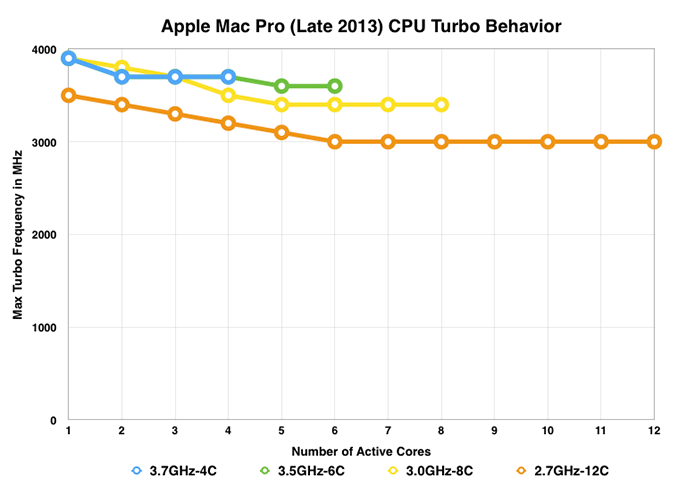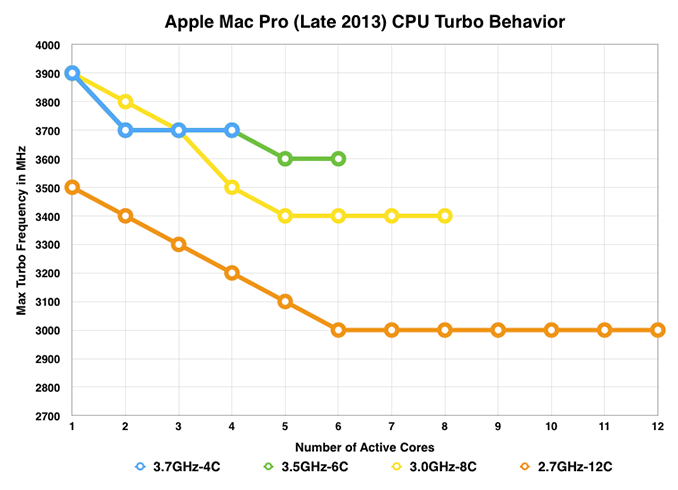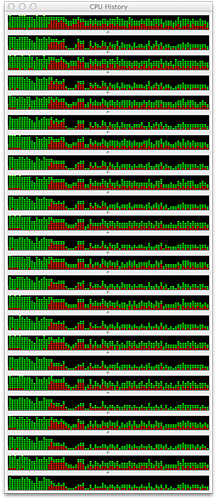The Mac Pro Review (Late 2013)
by Anand Lal Shimpi on December 31, 2013 3:18 PM ESTCPU Choices
Had I gotten around to publishing my rMBP review prior to this one you would’ve seen my praise Apple’s CPU selection abilities as of late. Outfitting all 15-inch rMBPs with Crystalwell was a very wise move on Apple’s part. With the Mac Pro the CPU selection is good, but the decision of what to buy is far more complex than in any other product line.
The Mac Pro not only serves as Apple’s ultra high end Mac, but it’s the only option if your needs exceed that of an iMac or 15-inch MacBook Pro. Literally anyone who needs more performance than Apple offers in an all-in-one or a notebook inevitably is pushed to consider the Mac Pro. With a relatively broad professional audience in mind, Apple offers more CPU options for the Mac Pro than on any other shipping Mac:
| Mac Pro (Late 2013) CPU Options | ||||||
| Intel CPU | Xeon E5-1620 v2 | Xeon E5-1650 v2 | Xeon E5-1680 v2 | Xeon E5-2697 v2 | ||
| Cores / Threads | 4 / 8 | 6 / 12 | 8 / 16 | 12 / 24 | ||
| CPU Base Clock | 3.7GHz | 3.5GHz | 3.0GHz | 2.7GHz | ||
| Max Turbo (1C) | 3.9GHz | 3.9GHz | 3.9GHz | 3.5GHz | ||
| L3 Cache | 10MB | 12MB | 25MB | 30MB | ||
| TDP | 130W | 130W | 130W | 130W | ||
| Intel SRP | $294 | $583 | ? | $2614 | ||
| Apple Upgrade Cost (Base Config) | - | +$500 | +$2000 | +3500 | ||
| Apple Upgrade Cost (High End Config) | - | - | +$1500 | +3000 | ||
There are four CPU options, each with varying core counts. The more cores you get, the lower your base CPU frequency is. In the old days, that would be the end of the discussion - you either choose more cores or more frequency, a tradeoff that is ultimately determined by your workload. Starting with its Nehalem architecture back in 2008, Intel introduced two key technologies that changed the face of multicore on the desktop: power gating and turbo boost. The former is a technology that can almost entirely remove power to a core (both active and leakage) when idle, while the second takes advantage of that freed up thermal budget to drive any active core(s) at higher frequencies. Subsequent implementations of Intel’s Turbo Boost technology have scaled the aggressiveness of this opportunistic frequency scaling, but the basic principle remains the same.
Apple advertises core count and base frequency for all of the Mac Pro CPU options, but to really understand what you’re getting yourself into you need to look at each CPU’s max turbo states vs. number of active cores. Neither Apple nor Intel do a great job of publicly exposing this information, Apple avoids doing so in order to keep things clean/simple, and Intel avoids doing so because perhaps it’s fun? Either way I’ve compiled the data on the four CPU options into the charts below.
I've left base clocks out of the graphs although you can see them noted in the legend at the bottom of each chart.
This first chart has the y-axis starting at 0MHz, but the next one is the more interesting as it starts at 2.7GHz and better illustrates/exaggerates the sort of frequency tradeoff you can expect vs. core count:
The 4, 6 and 8 core CPU options all offer the same peak single core frequency (3.9GHz). This is very important as single threaded performance remains the gate for system responsiveness outside of thread heavy applications. The 12-core CPU sacrifices around 10% of this peak single core performance.
Early on the 8-core CPU holds the advantage over the rest, being able to hit a higher 2-core max turbo. The octa-core’s crossover point happens at 3 active cores, beyond this point the quad and six core CPUs maintain a slight max turbo advantage.
The key takeaway here is that more cores isn’t necessarily better. You need to weigh the needs of your applications against the number of cores in your system. There is no one-size-fits-all answer here. For kicks I looked at the CPU load for a handful of my benchmarks:
![]()
![]()
![]()
Application version seems to have a huge impact on threading. Running our Photoshop benchmark on CS5 vs. CS6 is the difference between loading 2 - 8 cores vs. 3 - 10. The same is true if I compare Final Cut Pro 10.0 vs. 10.1; the latest version from Apple (optimized for the new Mac Pro), makes great use of all 12 cores/24 threads. Workload also has an impact. I took our old Final Cut Pro 10.0 benchmark (1080p) and ran it on 10.1, saw a maximum of 1217% CPU usage. I ran our new 4K benchmark on 10.1 and saw nearly full virtual core utilization (2114% CPU usage).
![]()
Final Cut Pro 10.0 - 1080p Benchmark
![]()
Final Cut Pro 10.1 - 1080p Benchmark
![]()
Final Cut Pro 10.1 - 4K Benchmark
Offline 3D rendering applications typically have the easiest time of chewing up tons of cores, while many others are likely better suited by having fewer cores running at a higher frequency. There's also a serious multitasking benefit if you're the type of person that runs multiple thread heavy workloads in parallel. It's pretty nice having a fairly responsive system while rendering a beefy 4K project in Final Cut Pro. The responsiveness comes courtesy of having a ton of cores in addition to extremely fast IO. That PCIe SSD definitely comes in handy.
If you want the best balance of heavily threaded performance without sacrificing performance in lighter workloads, the 8-core configuration seems to be the best bet. There are definitely bragging rights associated with the 12-core system, but unless you absolutely need a ton of cores you’re likely better suited by the 8-core configuration.













267 Comments
View All Comments
Ryan Smith - Wednesday, January 1, 2014 - link
The device ID for the D700 is identical to the 7970 (1002-6798), so it will show up as a Radeon under Windows. Conversely, a 7970 may very well show up as a D700 under Mac OS X if the only thing being checked is the device ID.666sheep - Thursday, January 2, 2014 - link
It used to be device ID only, but it has changed in 10.9.2 drivers. Now 7970 (and 7870 XT) are recognized as "themself", like in 10.8. So there's another check, most likely vendor and/or subsystem ID.BTW, D500 and D700 are based on the same core - Tahiti XT2 and share one EFI ROM (but not the PC part, these are different for each card). I sent Anand an email with more detailed info.
tipoo - Thursday, January 2, 2014 - link
But can you install FirePro drivers for it under Windows?666sheep - Friday, January 3, 2014 - link
I doubt that at this moment drivers other than Apple Bootcamp ones will detect these cards as FirePro. One should test this empirically, though.wheelhot - Saturday, January 4, 2014 - link
Yes, I'm one of them as I'm using Solid Edge in Windows and wonders if the D300/500/700 is supplied with actual FirePro drivers in Windows or not. Anyone care to clarify?I've been searching for anyone to run a specviewperf test as it'll be easier to know if they truly comes with a FirePro GPU drivers or not in Windows, sadly none yet :(
melgross - Tuesday, December 31, 2013 - link
I'd like to see a comparison pricing between the Mac Pro and a DIY machine using the same processors, not the i7. Whatever the difference, it's not the same type of machine if the CPU's are entirely different. That price difference, and possibly that of the mobo will be drastic, I would imagine, and would be a fairer comparison.acrown - Tuesday, December 31, 2013 - link
Lucky for you that someone did that already then:http://www.futurelooks.com/new-apple-mac-pro-can-b...
Spoiler - the Mac Pro is cheaper when you attempt to keep the same design restraints.
lilo777 - Tuesday, December 31, 2013 - link
Don't be ridiculous. The guy has no clue. He used two AMD W9000 cards as if this is is what D700 is.itpromike - Tuesday, December 31, 2013 - link
Apparently you have no clue... The W9000 is spec for spec the exact same card as the D700. Every single spec and number are identical. Aside from Apples stupid and pointless naming convention this card is the same.KVFinn - Tuesday, December 31, 2013 - link
>The W9000 is spec for spec the exact same card as the D700. Every single spec and number are identical.The W9000 is different, it has ECC ram for example. It's spec for spec the same as the 7970 but clocked lower.
Though most of the differences in Pro grade GPU are confined to drivers.